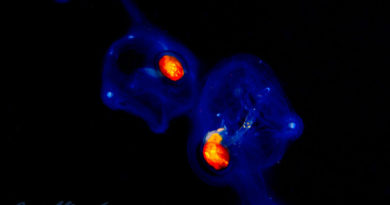Red
In Thailand, the “Red shirts” are the political fraction in favor of the elected government. But that’s not why my new dive buddy and fellow deep diving instructor candidate Stuart is wearing a red shirt. It’s to demonstrate how light absorption changes colors underwater.
I took the image on the left on land, without a strobe. No, he doesn’t have an unusually large head – it’s a distortion by a wide angle lens. As you can see, if you aren’t color blind – a condition more prevalent in human males than females due to the location of some retinal proteins on the X-chromosome – the t-shirt is bright red.
The next shot, in the middle, is the same dive buddy wearing the same t-shirt, but about 10 meters deep. Here, a small bit of red light reaches us, and the shirt is a tad red. Depth makes a difference!
And the picture on the right is the same Stuart, again with the same red t-shirt, photographed with the same camera and lens, again without a strobe, in 37 meters of depth. Wow! The red has turned completely black. Water absorbs long light wavelengths (red) most effectively, and by the time divers reach 37 meters, very little red light is left to reflect from the red pigment of the t-shirt.
How deep do you have to go before you have no red left? That depends on the exact conditions that day. On a sunny day in the tropics, with great visibility and few waves to reflect light on the surface, you will still see red colors from ambient light when you are 20 meters deep. In Sydney, on a nice sunny day, but with less visibility, 10 meters deep as in the image above, is about when you will see the last bit of red. In a really murky dive site on an overcast day, you’ll already end up red-less at a depth of a few meters.
And that’s why I am not a fan of red-filters for cameras or video-cameras: Such a red-filter preferentially lets red light pass through, to the exclusion of other colors (shorter light wavelengths). But the amount of red-filtering will only be correct for one depth, or one visibility or light level. If you go a bit deeper, or some clouds occlude the sun, or if the viz is a bit worse than last week, the amount of red filtering will not be right anymore. It’s so much better to either 1. use an artificial light source like a strobe or a video-light or 2. just record the unfiltered images, and correct for colors afterwards in software, using Photoshop or GIMP. There, you can remove the exact amount of non-red light you like to. You can just as easily remove blues and greens on your computer, and you will not loose light strength while taking photographs or shooting video. Naturally, a red filter will reduce the amount of light reaching the camera’s sensor. Makes sense?
We did the red-shirted dive to become PADI deep diving instructors, so if you like, I can now teach you to dive deep safely in the Deep Diver course with Abyss Scuba Diving in Sydney. If you’d like me to be your instructor for this interesting course, ask to be taught by me when you contact Abyss.



